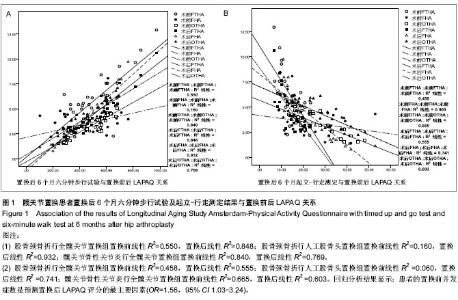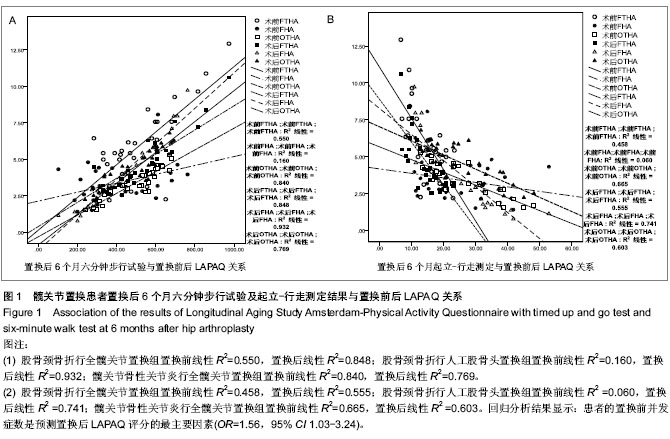| [1] Zi-Sheng A, You-Shui G, Zhi-Zhen J,et al.Hemiarthroplasty vs primary total hip arthroplasty for displaced fractures of the femoral neck in the elderly: a meta-analysis.J Arthroplasty. 2012;27(4):583-590.[2] Stratford PW, Kennedy DM, Riddle DL.New study design evaluated the validity of measures to assess change after hip or knee arthroplasty.J Clin Epidemiol. 2009;62(3):347-352. [3] Ghomrawi HM, Franco Ferrando N, Mandl LA,et al.How Often are Patient and Surgeon Recovery Expectations for Total Joint Arthroplasty Aligned? Results of a Pilot Study.HSS J. 2011;7(3):229-234.[4] Lozano Calderón SA, Shen J, Doumato DF,et al.Functional Outcomes in High-function-demand patients after total knee arthroplasty.Orthopedics. 2012;35(5):e681-690.[5] Foucher KC, Hurwitz DE, Wimmer MA.Preoperative gait adaptations persist one year after surgery in clinically well-functioning total hip replacement patients.J Biomech. 2007;40(15):3432-3437.[6] Mancuso CA, Sculco TP, Salvati EA.Patients with poor preoperative functional status have high expectations of total hip arthroplasty.J Arthroplasty. 2003;18(7):872-878.[7] Fortin PR, Clarke AE, Joseph L,et al.Outcomes of total hip and knee replacement: preoperative functional status predicts outcomes at six months after surgery.Arthritis Rheum. 1999; 42(8):1722-1728.[8] Holtzman J, Saleh K, Kane R.Effect of baseline functional status and pain on outcomes of total hip arthroplasty.J Bone Joint Surg Am. 2002;84-A(11):1942-1948.[9] Santaguida PL, Hawker GA, Hudak PL, et al. Patient characteristics affecting the prognosis of total hip and knee joint arthroplasty: a systematic review. Can J Surg. 2008; 51(6):428-436.[10] Heiberg KE, Ekeland A, Bruun-Olsen V, et al. Recovery and prediction of physical functioning outcomes during the first year after total hip arthroplasty. Arch Phys Med Rehabil. 2013;94(7):1352-1359.[11] Slaven EJ.Prediction of functional outcome at six months following total hip arthroplasty.Phys Ther. 2012;92(11): 1386-1394.[12] Nankaku M, Tsuboyama T, Akiyama H,et al.Preoperative prediction of ambulatory status at 6 months after total hip arthroplasty.Phys Ther. 2013;93(1):88-93.[13] Wollmerstedt N, Nöth U, Ince A, et al.The Daily Activity Questionnaire: a novel questionnaire to assess patient activity after total hip arthroplasty.J Arthroplasty. 2010;25(3): 475-480. e1-3. [14] Ware JE, Kosinski M, Keller S.SF-36 Physical and Mental Health Summary Scales:A User's Manual. Boston,MA:The Health Institute, New England Medical Center;1994[15] Verweij LM, van Schoor NM, Dekker J, et al. Distinguishing four components underlying physical activity: a new approach to using physical activity questionnaire data in old age. BMC Geriatr.2010;10:20. [16] Podsiadlo D, Richardson S.The timed "Up & Go": a test of basic functional mobility for frail elderly persons.J Am Geriatr Soc. 1991;39(2):142-148.[17] Escalante Y, García-Hermoso A, Saavedra JM.Effects of exercise on functional aerobic capacity in lower limb osteoarthritis: a systematic review.J Sci Med Sport. 2011; 14(3): 190-198.[18] Rooks DS, Huang J, Bierbaum BE,et al.Effect of preoperative exercise on measures of functional status in men and women undergoing total hip and knee arthroplasty.Arthritis Rheum. 2006;55(5):700-708.[19] de Groot IB, Bussmann HJ, Stam HJ,et al.Small increase of actual physical activity 6 months after total hip or knee arthroplasty.Clin Orthop Relat Res. 2008;466(9):2201-2208. [20] 曾润铭,林菁,吴杰,等.家庭太极和肌力训练改善髋关节骨关节炎患者活动功能[J]. 国际医药卫生导报, 2013,19(13):1915-1919.[21] Kawanabe K, Kawashima A, Sashimoto I,et al.Effect of whole-body vibration exercise and muscle strengthening, balance, and walking exercises on walking ability in the elderly. Keio J Med. 2007;56(1):28-33.[22] van Dijk GM, Veenhof C, Spreeuwenberg P,et al.Prognosis of limitations in activities in osteoarthritis of the hip or knee: a 3-year cohort study.Arch Phys Med Rehabil. 2010;91(1): 58-66.[23] Stewart NA, Chantrey J, Blankley SJ,et al.Predictors of 5 year survival following hip fracture.Injury. 2011;42(11):1253-1256. [24] Stevens M, Wagenmakers R, Groothoff JW,et al.Physical activity behavior after total hip arthroplasty (THA): a prediction based on patient characteristics.Patient Educ Couns. 2007; 69(1-3):196-199.[25] Singh JA, Lewallen DG.Predictors of activity limitation and dependence on walking aids after primary total hip arthroplasty.J Am Geriatr Soc. 2010;58(12):2387-2393.[26] Bhave A, Marker DR, Seyler TM,et al.Functional problems and treatment solutions after total hip arthroplasty.J Arthroplasty. 2007;22(6 Suppl 2):116-124. |





